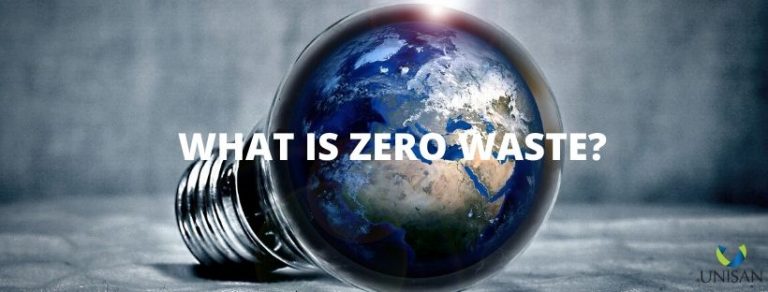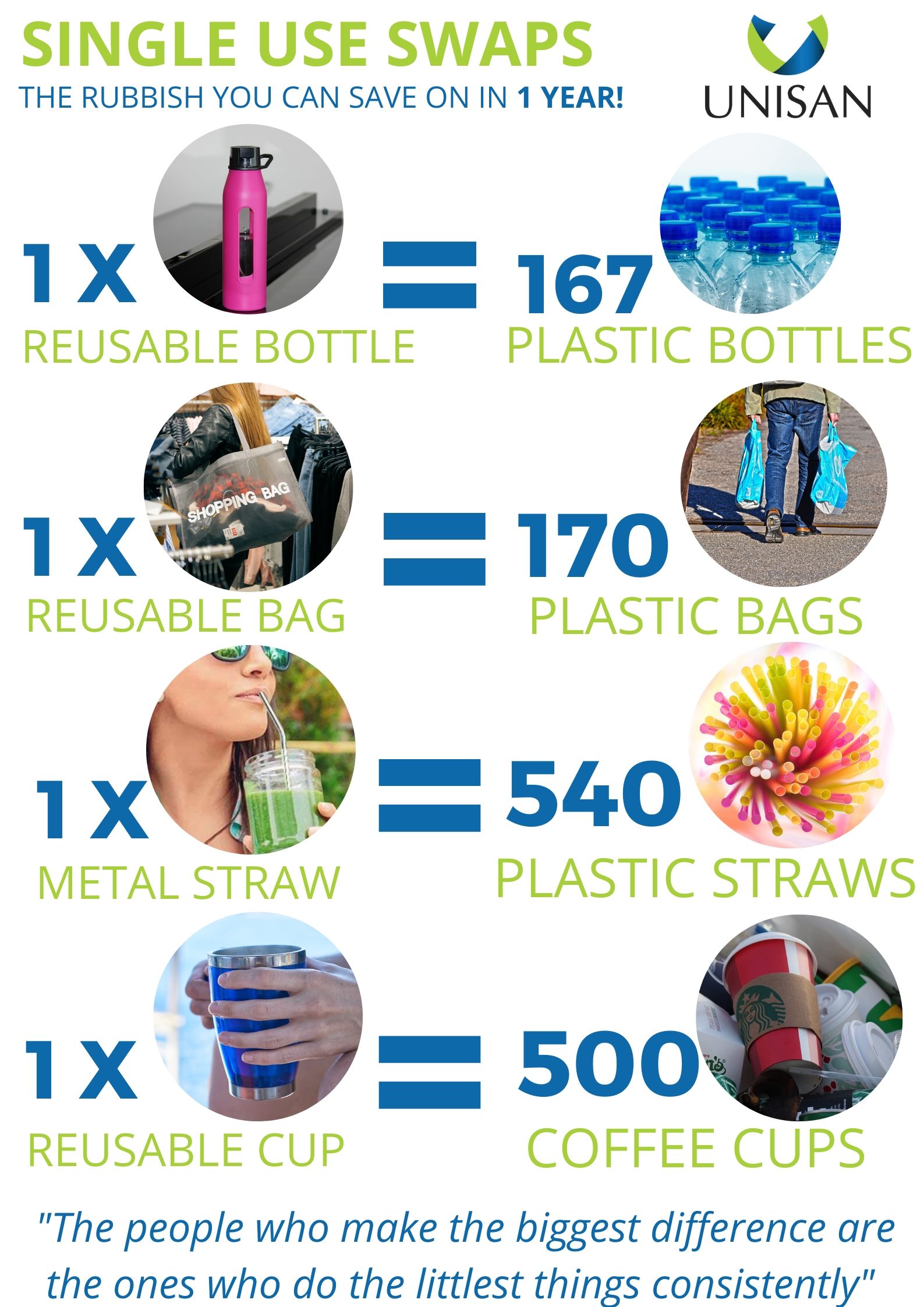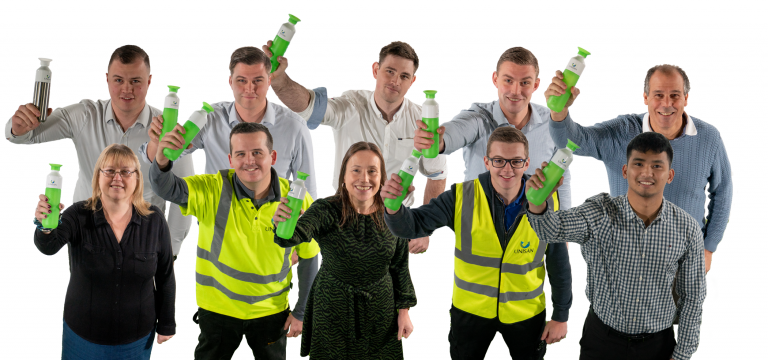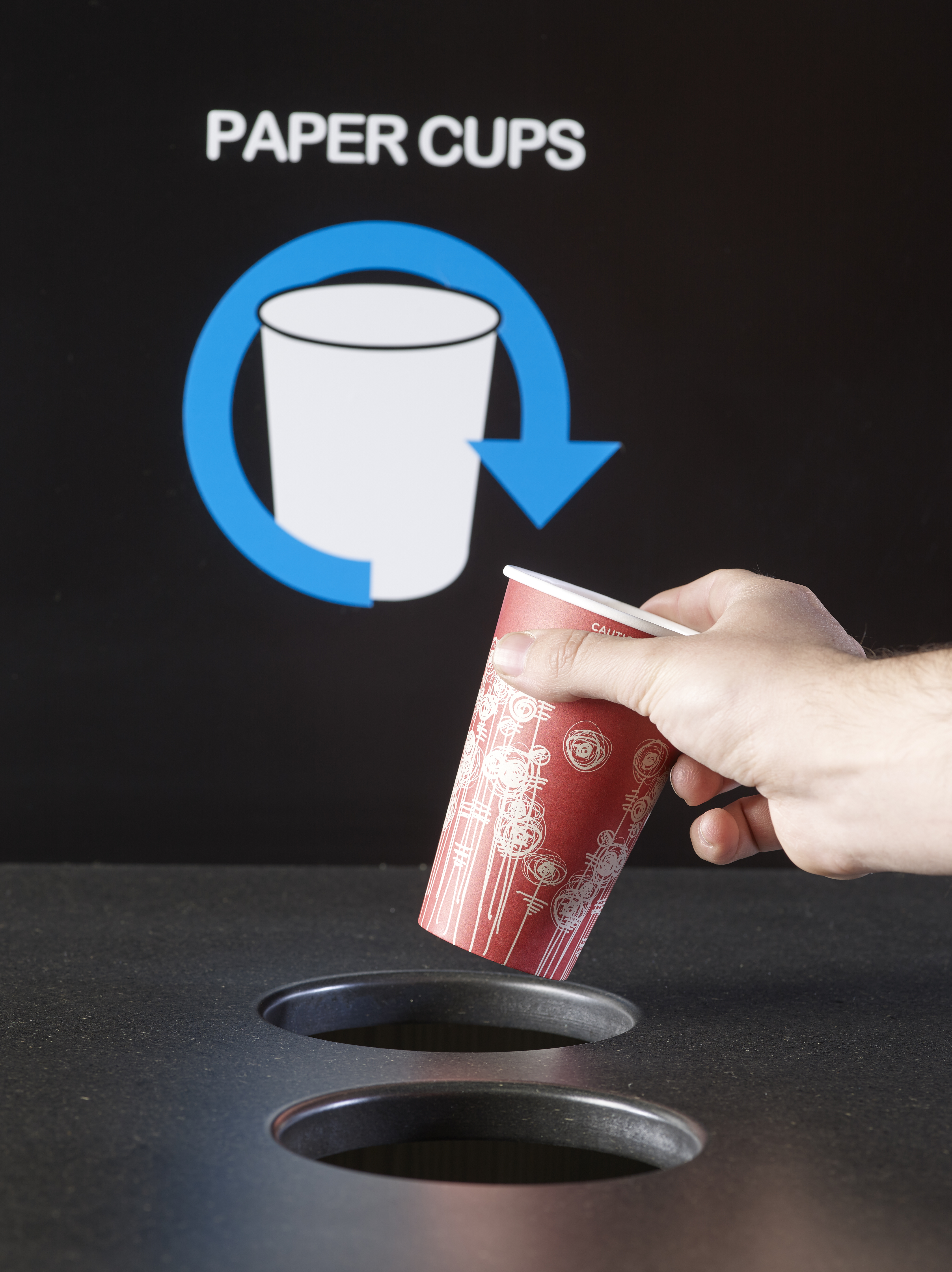
You may have heard the term ‘Zero waste’ or ‘zero waste lifestyle’ or ‘zero waste movement’ a lot recently, but what exactly does it mean? What Does a Zero-Waste Mean?
Living a zero-waste lifestyle whether at home or in your business, means you strive to use as little single-use plastic as possible, instead opting for sustainable and reusable alternatives. In short, it means you send as little as possible to landfills, which can damage the environment and natural habitat around them. Replacing as much as possible with reusable products includes everything from clothing, to food and drink packaging, to hygiene products, either more sustainable or plastic free, which will ultimately protect the environment, benefit communities and support a circular economy. The 3 R’s play an important role in this; Reduce, Reuse, Recycle. This means reducing what you use, reusing as much as you can, send whats left to recycling, and compost what you cannot, then finally the small part of waste left goes to landfill.
Zero waste may sound like an unachievable pie in the sky goal, but it is just a goal, a visionary term with the intention of having a positive impact on the planet. We all know it would be virtually impossible to have absolutely Zero waste in our lives. It’s not really about perfection; it’s about making a conscious effort to make better choices.
What is a circular economy?
While living low waste, reducing, reusing, and repairing as much as we can is wonderful – it’s still not circular. The goal of zero waste is to move to a circular economy, which is where rubbish has no existence. The circular economy mimics nature in that there is no garbage in nature. Without a circular economy, we are regularly taking resources from the earth, then sometime after dumping them back in a hole in the ground. Natural resources are so valuable, we can’t afford them ever running out! So instead of discarding these resources, creating a circular economy means reusing items or sending them to be recycled, so they can be resumed fully back into the system.
Zero Waste means designing and managing products and processes to reduce the volume and toxicity of waste and materials, conserve and recover all resources, and not burn or bury them. Implementing Zero Waste will help reduce discharges to land, water, or air that may be a threat to planetary, human, animal or plant health and imitate sustainable natural cycles, where all discarded materials are resources for others to use.
Looking at the big picture, like preventing waste being produced in the first place is a lot more common now. Many manufacturing companies are looking at designing long-lasting, easily maintainable and repairable products, by reducing packaging and redesigning those products that cannot be safely reused, recycled and composted. By reusing parts and material coming from discarded products where every “waste” from one process becomes a source for another such that the utility of the material is maximised, is in line with a circular economy
What’s wrong with landfills?
A landfill site, or tip or rubbish dump, is a site for the disposal of waste materials. Waste is either dumped on the ground, or used to fill a large designated or unwanted hole. The decaying rubbish produces weak acidic chemicals which combine with liquids in the waste to form leachate and landfill gas, which can be toxic.
The U.S. EPA has estimated roughly 42% of all greenhouse gas emissions are caused by the production and use of goods, including food, products and packaging. Reducing, reusing and recycling will conserve that energy and dramatically reduce our carbon emissions. By reducing the amount of trash you create, you could literally save thousands of pounds of trash from entering landfills — proving that one person really can make a difference.
Animals, plants, and future generations are all facing the sad effects of landfill. The food waste found in landfills attracts birds, mammals and rodents alike to feast on leftovers, however it is often not suitable for animals, and can give them food poisoning.
Llandfills are changing and destroying animals natural habitats. Cutting down trees and clearing land to extend our landfill sites is clearing out the homes of hundreds of different species. Loss of habitat is one of the largest threats to 85% of the species in the International Union for the Conservation of Nature (IUCN) Red List, according to WWF.
Not only do landfills have a direct effect on animals, they are having an indirect effect on them too. Waste sent to landfill is often overloaded with chemicals that can disturb plant growth in nearby areas if it leaches into the ground. The chemicals contaminate plants and waters, and as scary as it sounds, this contamination at the very origin of the animal hierarchy means that all species in the food chain could be affected.
Waste in landfills, whether it’s biodegradable, plastic, or anything in between, will emit greenhouse gases, which directly contribute to climate change. Read our full blog post here on why landfills cause pollution and are bad for the environment.
Engaging the community
The success of any zero waste goal relies on education and participation of communities and business organisations. Encouraging people to invent & adopt waste free practices and take active participation in the design of the resource management system towards waste reduction would be of invaluable benefit. Public education campaigns to inspire participation should be carried out, and they need to be well resourced and sustained.

How to start your zero waste lifestyle at home?
There are many simple ways to get started in working towards a zero-waste lifestyle. Many zero wasters recommend beginning by looking through your trash and recycling bins to see what you’re throwing out the most.
If your garbage can is filled with food scraps, you could start composting. If your bin is overflowing with paper products like napkins, paper towels, and tissues, invest in some cloth napkins, cleaning cloths (which you can easily upcycle from old towels), and handkerchiefs, or use an eco friendly version. If there is a lot of food packaging, start buying food from bulk sections where you can bring your own reusable container or packaging, or look for foods packaged in recyclable or sustainable packaging.

How to start your zero waste lifestyle at work?
-
Don’t forget about paper!
Although plastic waste is on everyone’s mind, the biggest volume of waste produced by the average office by far, is paper (60 – 80%!!). Paper is probably the waste which can be easily eliminated, or at least significantly reduced. Consider these ideas for reducing your paper waste:
- Think before you print – this is the digital age! How much do we really need to print these days? Start by just analysing how much of what you print could be digital, but consider changing your processes and operations to be more digital.
- Consider ‘pull printing’ or ‘follow-me printing’. A whopping 30% of printing is never collected from the printer. Setting up pull printing means that all users have to log in at the printer to access their printing – in other words it will only print when they come to collect it.
-
Utilize the hierarchy of waste
First of all, reduce and reuse. We’ve already talked about how you can reduce paper waste, so here’s some tips on reducing plastic waste:
- Remove plastic straws from your office
- Ban disposable cutlery and plates
- Cut down on single-use food packaging
- Switch to re-usable drinks bottles and coffee cups
- Work with your suppliers to decrease product packaging
- Analyse your own processes to see how you could decrease packaging
Then recycle… This is the bit everyone concentrates on. If you’re struggling, we’ve got some great tips in this blog post to help you boost your recycling rates.
Next up…recovery…
This is the bit that many businesses give little thought to, but it’s what bridges the gap between good recycling rates and zero waste. Because even if it can’t be recycled, it can still be contributing to a circular economy. The most common form of recovery is energy from waste (EfW), where waste is used to create a sustainable form of energy. Other forms of recovery include composting, biomass, anaerobic digestion and creating wood pellets for fuel.
Speak to your waste management company to see what they can do for you – many companies today will offer EfW for all your non-recycled waste.
3. Set up an effective bin system
Setting up an effective recycling station can make all the difference. We have a whole blog post on this, but here’s a few really quick tips to give you some pointers.
- Clear labelling – make sure your communicate in a crystal clear way what can go in each bin.
- Make sure there’s enough of them – make sure that it’s just as easy for your staff to correctly recycle waste as it is to just put it in general waste.
- Remove personal bins – having bins under every desk makes it too tempting to just put all waste in one bin. Remember, the goal is to make recycling as easy as single-stream waste disposal; which may have to mean making it harder not to recycle!

-
Educate your staff!
Recycling is complicated! The UK’s recycling system is complex and disjointed – a recent study by WRAP found that UK councils run 39 different waste collection schemes, and that’s just councils. Each waste management company also uses its own system, and has its own different rules as to what can and can’t be recycled.
It’s vital that all staff know exactly what they can and can’t recycle at work for several reasons; firstly if your waste streams are contaminated then they can’t be recycled, but also if you’re staff fully understand the recycling process at your office, then they’re far more likely to be bought into it in a fuller way, and be more committed to your goal of zero waste. Here are a few ideas to help you get full buy-in from all your staff.
- Run a waste awareness day/programme. The key to ensuring staff know what they can recycle is to enable them to fully understand the process; don’t just tell them what, tell them why. Some waste management companies today will actually run an event at your workplace, giving staff in insight into the process behind their waste management.
- Create clear signage. Make your bin system completely fool-proof with clear signs and graphics showing exactly what goes in each bin. This way, anyone who uses the bin can tell at a glance where to put their waste.

-
Consider specialised recycling
Sound technical? It’s not as bad as it seems. A lot of waste streams, especially different types of plastics, are recyclable, but most companies don’t recycle them as it is not commercially viable. However, if your company produces a lot of a certain amount of waste, then getting specialised recycling for just that one stream may be worth considering.
Some waste streams to consider could be plastic packaging (e.g. polystyrene), wood, or electrical equipment. You could also consider setting up a specific waste stream for waste that would usually go in mixed recycling, such as glass. These specific streams will not only have a higher value per tonne, they will also have a greater value to the circular economy.
One stream that almost every office can consider is single-use coffee cups. All offices get through a huge amount of these each day, and usually they’re all thrown into landfill. Speak to your waste manager to see what they can do for you.
Have you noticed a theme here? Several times throughout this post, we’ve mentioned collaborating with your waste management company, and that is vital to achieving your zero waste goal. You could really break this whole post into two steps: number 1, get your reduction, re-use and recycling as good as you can; number 2, collaborate with your waste broker to take it to the next level.

So to get back to our original question; how hard is zero waste to achieve? Well, ultimately it’s up to you to decide how it could work in your organisation, but our belief is that it’s not as hard as people commonly perceive it to be. Every organisation is different, and obviously it’s going to be more commercially viable for a larger organisation, but everyone has to start somewhere, and even the smallest of teams can make some simple steps to get started on the zero waste journey.
We are proud to help businesses and organisations overhaul (or start!) their recycling, and have successfully aided many to becoming more sustainable companies, dramatically increasing their recycling rates. Find out more here on how we help transform companies environmental commitments for the better, or call us on 0300 700 6000 for expert advice on how your business can move further towards zero waste!
